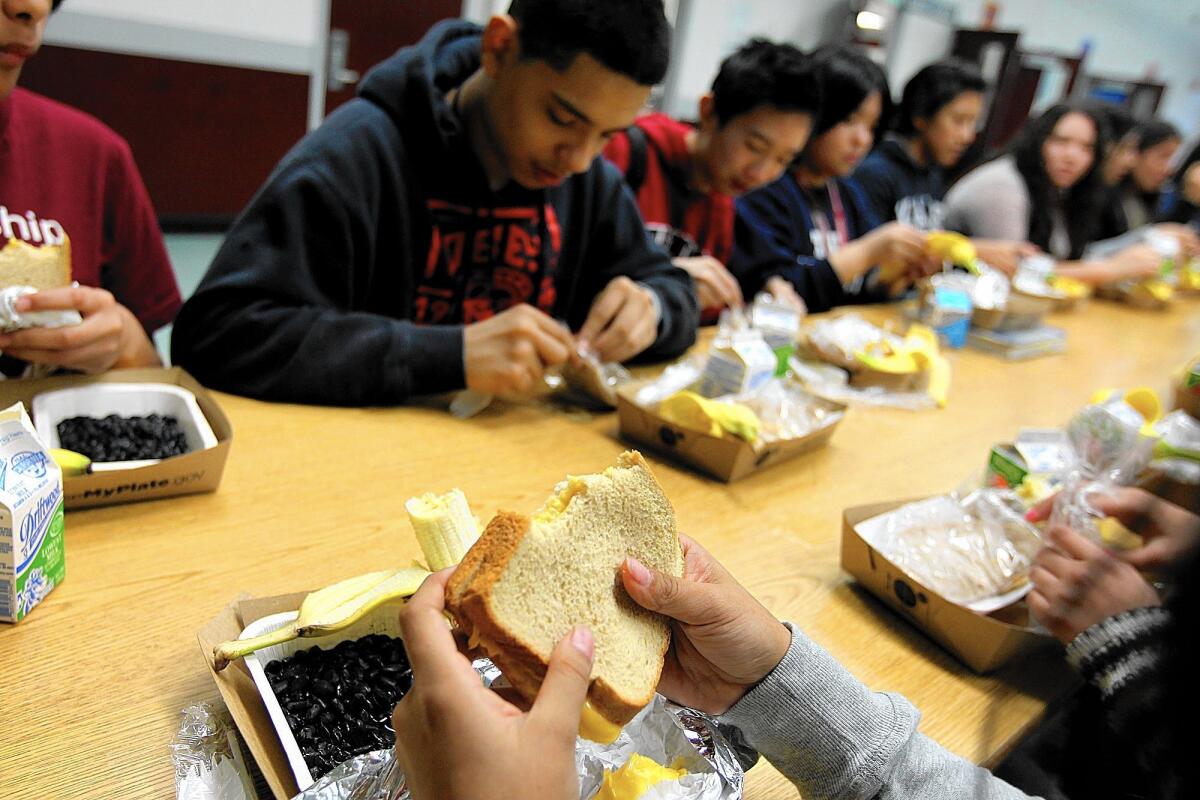‘Lunch lady’ lobby joins GOP to fight Obama’s school lunch rules

In the farm-to-fork-crazed city of Portland, Ore., campus gardens supply public school cafeterias and food service workers seek out chicken free of antibiotics.
But the school system’s nutritional director finds there’s one advocate for healthy food whose demands she just can’t meet — Michelle Obama.
“We have tried every noodle that is out there,” said Gitta Grether-Sweeney, the Portland nutritional director who says she is exasperated by the federal school lunch rules the first lady champions. “Whole-wheat noodles just don’t work in lasagna. We are having to go lawless to use regular pasta.”
------------
FOR THE RECORD:
School lunches: In the April 22 Section A, an article about the political fight over school lunch rules referred to the 2010 law that created new federal nutritional standards for the meals as the Healthy School Meals Act. It is the Healthy, Hunger Free Kids Act.
------------
The locally sourced macaroni and cheese the schools had been serving turned to mush when it was made with whole-grain macaroni to meet the new rules, Grether-Sweeney said.
That once-popular meal is now off the menu. So too are wraps, which she says won’t hold together with the brittle wheat tortillas she now must use. Many fewer meals are getting sold at school, she said.
Food service directors like Grether-Sweeney have been warmly embraced by Republicans who are trying to undermine federal school lunch rules that they see as the cornerstone of a nanny-state agenda from the first couple.
In response, the Obama administration has put together its own coalition of celebrity chefs, health organizations and military leaders to mitigate the damage caused by its falling-out with the “lunch lady” lobby — 55,000 school cafeteria workers who were once a major ally.
Back in 2010, when it passed, the Healthy, Hunger Free Kids Act was seen as a landmark nutritional achievement for the most health-conscious White House in recent memory.
------------
FOR THE RECORD
9:11 a.m.: An earlier version of this article stated the name of the 2010 law that created new federal nutritional standards for school meals as the Healthy School Meals Act. It is the Healthy, Hunger Free Kids Act.
------------
Now, as the Republican-dominated Congress decides whether to renew the law, school lunch trays have become a partisan battle zone. The law expires on Sept. 30, although the status quo will remain in place if Congress deadlocks.
“We should not have what is served for lunch at schools decided by bureaucrats in Washington,” said Rep. Kristi Noem (R-S.D.), who wrote one of multiple bills that would ease the rules. “This has become a burden.”
The law and the regulations it spawned require school lunches to include significantly more fruits and vegetables and an infusion of whole grains; they also mandate a big drop in calories. Schools were told to cut the salt and sugar in foods they sell, even in campus vending machines.
Supporters of the law say that unwholesome frozen pizzas, chicken nuggets and other junk food that once were lunchtime staples helped drive the nation’s epidemics of childhood obesity and diabetes.
They question whether the intense pushback against the new standards truly reflects the concerns of lunch ladies or the views of big processed-food companies that bankroll the School Nutrition Assn., which represents cafeteria workers in Washington.
“We believe they are being highly nudged by the interests that represent the frozen-pizza industry and some of the other processed-food folks that provide significant funding,” said Kevin Concannon, undersecretary for Food, Nutrition and Consumer Services at the Department of Agriculture. “Regressive parts of the industry want to act like we are not in the middle of a crisis in this country.”
And many schools are all for the new rules — particularly in California.
The former food service director at the Los Angeles Unified School District, where pizza is no longer on the menu, stood alongside the first lady last year as she kicked off her public campaign to defend the standards. State Supt. of Public Instruction Tom Torlakson has urged Congress not to weaken them.
Few things government does have as much impact as the school lunch program on the diets of Americans. More than 43 million subsidized lunches and breakfasts are served daily. They account for half of the calories many kids consume in a day.
The program was created in 1946 by a Congress alarmed that vast numbers of young men were ineligible to serve in World War II because they were undernourished.
Underfeeding is no longer the problem. Now, nearly a quarter of recruiting-age Americans are too overweight to serve, according to Mission: Readiness, a group of 500 retired military officials who argue that school lunch trays laden with junk food are a major culprit. Its leaders are confounded by the backlash against the new standards.
“It is amazing to us that this has become a political issue,” said retired Maj. Gen. D. Allen Youngman, former head of the Kentucky National Guard.
“There are a lot of ways you can characterize 500 admirals and generals,” he added. “But a hotbed of liberal thought is not the first thing that comes to mind.”
The new lunch rules are strict. Schools are being told to restock pantries with ingredients alien to many students’ palates.
If children pass up the fruit, cafeteria workers in many cases can’t sell them a meal until they take some, leading schools to complain they are paying for produce that ends up in the garbage.
There have been other growing pains. The number of meals sold took a steep drop with the introduction of the new rules, according to the Government Accountability Office.
In St. Charles Parish just outside New Orleans, where more than half the public school children qualify for free or reduced-priced school meals, the fluffy biscuit that long enticed them to eat a hot breakfast has been effectively outlawed. The children look at its whole grain replacement with bewilderment, said Teresa Brown, the school’s director of childhood nutrition.
“We are struggling to find a biscuit they are happy with,” she said. “It is grainy. The texture is strange to them.... These kids don’t eat these things at home. We don’t have anything in our cafeteria anymore that is white. They haven’t had time to adapt.”
Nutrition advocates say they sympathize, but they point to studies suggesting that after the expected bumpy rollout, schools are figuring out how to make the new menus work.
Consumption of healthy food is on the rise, supporters of the program say. They point to temporary waivers that allow struggling schools to continue serving chewy, white noodles.
Some eager districts are engaging students in taste tests, surveys and promotional campaigns, using the nutrition mandates as a catalyst to elevate their dining experience.
A letter from 19 past presidents of the School Nutrition Assn. urged the administration not to bend to the demands of their own group. The American Academy of Pediatrics, the American Medical Assn. and the American Heart Assn. have joined the USDA in campaigning against any weakening of the rules.
Suppliers like Domino’s and Pizza Hut have reformulated the pizzas they sell to schools with whole grains and low-fat cheeses, and pasta companies are scrambling to figure out how to make whole-grain products palatable to children.
The federal government is providing grant money to bring in expert chefs to assist districts that need help overhauling their menus.
Other grants can be used to convert kitchens into facilities better equipped to prepare healthy meals. That might include replacing deep-fat fryers and microwaves with high-tech combination ovens that use a steaming function to make baked foods taste fried.
Kansas Sen. Pat Roberts, a Republican, visited a school in his home state last month that enthusiastically embraces the new guidelines, and he told student reporters there he was impressed by the meals being served.
But don’t look to him to vote to renew the program.
“I just have a problem with the federal government,” Roberts said in a lunchroom video interview. “I don’t think our Founding Fathers sat around the table and said, ‘I have a great idea. Let’s mandate what people eat.’”
Twitter: @evanhalper
More to Read
Sign up for Essential California
The most important California stories and recommendations in your inbox every morning.
You may occasionally receive promotional content from the Los Angeles Times.











